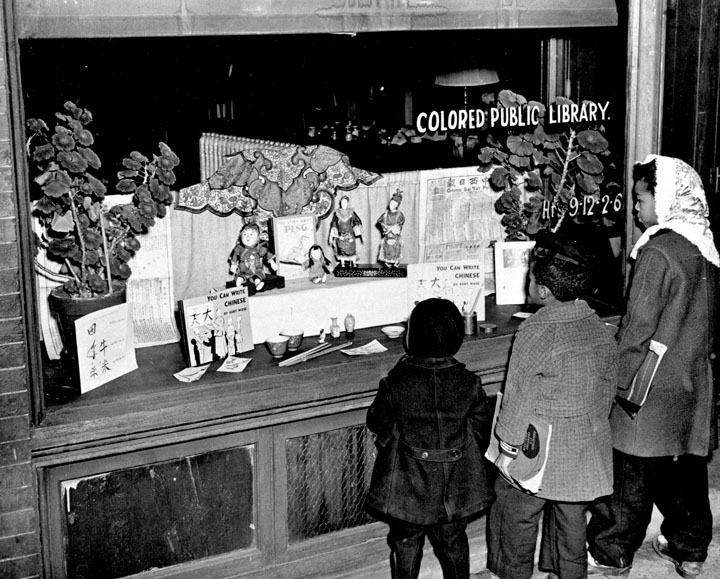This news item expired on Tuesday, October 4, 2022 so the information below could be outdated or incorrect.

A technology-saturated world can make it feel like our past is further away than it really is. Truth is, we’ve enjoyed some modern-day conveniences longer than we’ve had an integrated society. Buncombe County is full of people able to recall stories of our segregated past and the effort it took to gain civil rights. With that in mind, Buncombe County Special Collections (BCSC) has collected information about the Asheville Colored Library (also known as the Eagle-Market branch) while sharing stories about this historic facility.
In 1927, the library began lending books to the County’s Black population at its location in the YMI Building. After an organized and determined push by the Asheville Student Committee on Racial Equality (ASCORE), Asheville-Buncombe libraries became integrated in 1961. In celebration of 60 years of integrated libraries, BCSC collected and shared local stories about the days of the Asheville Colored Library. Find stories from beloved librarian Irene O. Hendrick, and other related information about this historic facility in Special Collections at Pack Memorial Library.
Learn more about the Asheville Colored Library with the below Q&A with Collections Manager Katherine Cutshall.
Please provide a brief history of the Asheville Colored Library.
The Asheville Colored Library, located in the YMI building, began lending books in 1927. The City of Asheville hired Irene O. Hendrick as the librarian. This was the only library in Buncombe County that provided services for Black residents. In the 1950s, the library was made an official branch of the Asheville-Buncombe system and began using the name Eagle-Market Branch or Market Street Branch. In 1961, Asheville-Buncombe libraries were integrated, and the branch closed upon Mrs. Hendrick’s retirement in 1966.
Why was this library important to Buncombe’s Black residents?
The Eagle-Market branch was the only public library for Black residents of Buncombe County until September 1961 when all city libraries were integrated. The library served as a place for folks to find information for personal development, books for pleasure reading, and opportunities to participate in community programs. The Eagle-Market branch also provided a cultural and social hub for Asheville’s Black residents.
Who was Mrs. Hendrick, and what was her significance for this branch?
A woman of extraordinary and extensive education, Irene O. Stewart Hendrick attended Florida A&M University and received her library science certificate from Spelman College. She continued her studies at Winston-Salem Teacher's College, Atlanta University, Howard University, and Teacher's College of Columbia University. She was employed by the City of Asheville in 1926 to organize the city’s first Black library, which opened in April 1927 with Mrs. Hendrick as head librarian. During her time there, she created a safe community space and developed a collection that featured African American authors and subjects relevant to her patrons. Her expansive children's section inspired a popular bi-monthly story hour sponsored by the Delta Sigma Theta Sorority. The Eagle-Market branch remained open until her retirement in 1966, having served the branch for more than 40 years. Hendrick died on March 26, 1992.
Why are you looking for stories now?
Sept. 29, 2021 will mark the sixtieth anniversary of integration in our local libraries. To acknowledge and celebrate this milestone, BCPL would like to collect and share stories about the Market Street branch and Irene Hendrick with our community. Ultimately, these memories would be saved as part of the Asheville-Buncombe Library System Collection at Buncombe County Special Collections at Pack Memorial Library.
When do you expect this project to debut and where can it be viewed?
We expect to release a video on the various County and library social media platforms in mid-October. The full interviews and written comments will be held as part of the Asheville-Buncombe Library System collection at BCSC, and like all special collections will be available for public research.
Please add anything else interesting or informative about the E-M library or this project.
The push to integrate local libraries was spearheaded by a group of local students known as ASCORE, the Asheville Student Committee on Racial Equality. The students wrote letters, attended library board meetings, and pushed the Library Board to vote on integration.
Attached below is a 2015 interview held by Buncombe County Special Collections with ASCORE member Viola Jones Spells who worked to desegregate the library and went on to become a librarian.
To learn more about ASCORE, the history of the library system, or other Buncombe County and WNC history, visit Buncombe County Special Collections. For more about BCSC, click here.
Table: News Item Documents
| File Name | Size | Type | Date & Time Added |
|
Viola Jones interview
| 21 KB |
| 09/13/2021 10:21 AM |